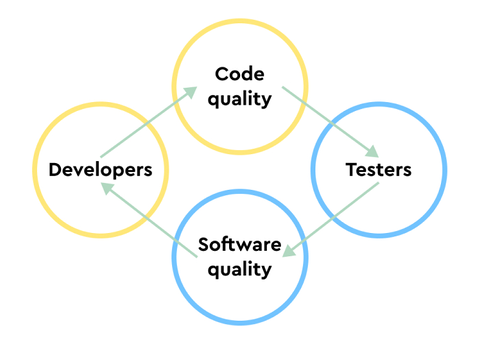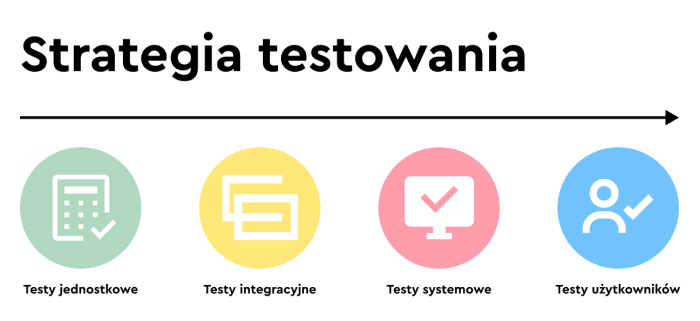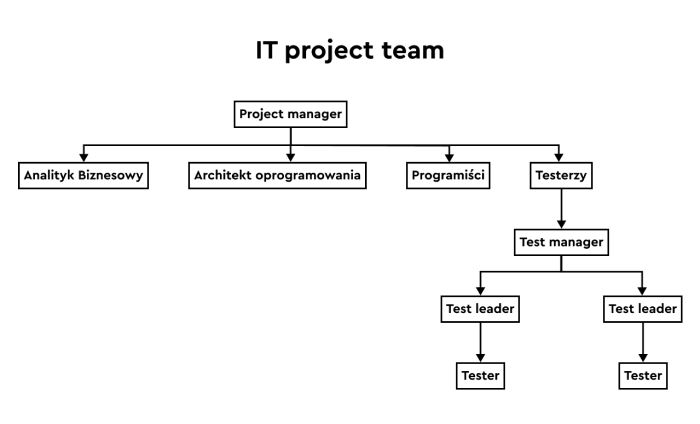In short, Software Testing can be defined as the process of verifying that an application's performance meets functional requirements.
Tests are carried out on the entire software as well as selected components. However, regardless of the scope of tests, their goal is always to detect errors, gaps, and defects.
In a nutshell, Software Testing allows us to dramatically reduce the cost of application development and offer products and services that are more efficient, more stable, and more secure. Testing and software quality are almost synonymous.
What are Software Testing, automated testing, and testing process? What does a software tester do? What are their responsibilities?
How does testing contribute to ensuring software quality in the IT industry? Why is the testing of web applications closely associated with software development?
What responsibility is in the hands of a software tester? Is Software Testing difficult?
How do we classify errors in Software Testing? Is online Software Testing effective?
Software Testing – what does it consist of? You'll find out soon enough!
What is Software Testing?
Software Testing increases the competitiveness of a digital product but also prevents many business and image crises that can occur due to offering products that haven't been subjected to various tests.
Neglecting Software Testing, unfortunately, has dire consequences, as companies such as Bloomberg, Nissan, Starbucks, Amazon, Microsoft, and China Airlines have learned very well. They're no exception; many companies made similar mistakes.
The extent and severity of possible problems can best be seen in the example of a software error that occurred in 1999 when the USA launched a military satellite worth more than 1 billion dollars.

And all because of insufficient attention to Software Testing.
Software Testing is a set of methods, tools, and practices that allow us to answer the question of whether the created digital product or software is free of defects or if it is in accordance with the specification of the requirements of the information system and the specification of functional requirements.
Software Testing aims to identify errors, gaps, or missing requirements.
Mainly, it is about checking whether:
- A given function works properly
- There are no conflicting functional and non-functional requirements
- The requirements have been implemented into the software completely
- User interfaces and APIs comply with the requirements
- An application provides an adequate level of security
- The communication between application components is smooth, seamless, and efficient.
We should conduct Software Testing in a planned, consistent, reliable, comprehensive, and clear manner.
In addition to technical problems, an important issue is the proper documentation of test processes, which should also be understandable for non-technical stakeholders.
Hence, we should write the reports in language that is as simple and easy to understand as possible.
Equally important, apart from the test results, is their communicative and convincing – including from the business side – justification.
It is worth remembering that software subjected to adequate, reliable testing provides the desired and real:
- Reliability and stability of operation
- High efficiency
- Protection and security – for end users and business owners
- User satisfaction – guarantees a better User Experience
- Savings – improving software already on the market is more costly than improving applications that are in the production process
- Labor and time savings.
Why is manual and automated Software Testing important?
History, unfortunately, knows of cases in which software defects have taken a toll on human lives in the ultimate way (China Airlines case).
Even if we assume that such drastic and dramatic situations are an exception, we're still talking about very loud business and image problems stemming from offering software that hasn't been tested, which resulted in imperfect or simply flawed software.
Financial losses, image losses, loss of market position, loss of credibility, loss of trust, and software seen as harmful and risky can be the reason for a business collapse or at least a long-term crisis.
To put it perhaps a bit harshly – we can't discuss the need for Software Testing. We should do it.

At least, if we don't want to share the fate of Nissan, which had to withdraw from the market more than a million of its cars in which the software that handles the airbag sensors contained hazardous bugs.
The data presented in the article "What is software testing?" published on IBM's blog makes a strong impression.
In 2016, software malfunctions (resulting from neglected testing) in the United States cost the U.S. economy more than 1 trillion dollars.
And they've translated into a real problem for more than four billion customers.
Organizations usually feel very reluctant toward testing because of its cost.
That is a very short-term perspective that doesn't consider that the immediate expense is a saving. Or simply an investment in business security.
The development and support of tested software are always less costly; however, untested software requires more budget, work, and time.
It's the best practice to subject software to testing at a very early stage of development so that it's possible to:
- React more quickly to discovered problems, which would become more problematic and costly as the project advances
- Increase reliability.
- Discover security vulnerabilities
- Discover malfunctioning functionalities
- Discover scalability issues
- Discover architectural flaws
For many years, Software Testing was performed at the late stages of digital product development, which often caused many problems – from budgetary to purely technological.
The Software Development Life Cycle didn't coincide with the Software Testing Life Cycle.
Currently, software development is dominated by the methodology of continuous, relentless testing, which is part of the DevOps approach, that allows the software to be delivered faster and in a more sustainable way in terms of cost, quality, and risk.
Software Testing Life Cycle
As we wrote above, Software Testing is a process within which we can distinguish different stages and phases arranged in a particular cycle.
And a life cycle is nothing more than a sequence of changes that software goes through. It simply goes from one form to another.
The Software Testing Life Cycle, if implemented in a well-planned manner, ensures that an organization gains as much control as possible over the quality of the software it develops.
We can call it a strategic approach to the quality of the created digital products and services.
By using a reasonable software testing life cycle, an organization achieves a quality strategy that is more likely to produce better results.
For this to happen, it's necessary to go through the subsequent phases properly, which include:
- Planning
- Preparation
- Execution
- Reporting.
In the planning phase, it's necessary to collect all the requirements (functional and non-functional) that are placed on a digital product or service.
Very often, software testers collaborate with business analysts in this regard.
We should write the list in the form of tasks that we should perform during the tests. The order of tasks is important, so they should be ranked according to priority.
In the next preparation phase, it's necessary to create a test environment, collect all test cases, and study product features and test cases.
That is also the moment to prepare software testing tools and adjust the types and techniques of testing.
In the execution phase, as the name suggests, specific Software Tests are performed, and their results are confronted with assumptions and expectations.
In the reporting phase, it's essential to document all results, analyses, and diagnoses in a simple and communicative form.
What are the types of Software Testing? Examples of Software Testing
Software Testing is a field that is developing rapidly, which is why many types of Software Testing serve very different purposes.
In the most general sense, according to the criterion of how the test is performed, testing of desktop or mobile applications can be divided into:
- Software Testing – manual tests
- Software Testing – automated tests
Testing of web and mobile applications in the manual variant is performed by a tester who interacts with software interfaces in a suitable test environment and checks how they work.
Manual tests, like all types of tests, are imperfect and have peculiar limitations.
The most important include the following:
- High cost
- Susceptibility to typical human errors (such as missing a test case).
These limitations have led to a significant popularization of automated tests, which are much more reliable, complex, faster, and, ultimately, cheaper.
Automated testing is recommended primarily because of the possibility of using diverse test scenarios.
Currently, they've become one of the key elements of quality control in the process of development and adding new features to an application.
Another popular division of Software Testing is the division into:
- Black-box testing
- White-box testing
- Gray-box testing
Black-box testing (used for functional testing) involves testing software without knowing the structure of its code and implemented logic.
They're tests conducted from the perspective of the end user. Their purpose is to check the performance of application interfaces and software.
Unlike black-box testing, white-box testing is used to test the heart of an application or software and, therefore, its code. Its primary purpose is to check a code's consistency, cleanliness, conciseness, and security.
White-box testing doesn't focus on the performance of an application but allows us to check the strengths and weaknesses of software from the purely technical side.
In turn, gray-box testing, which is a hybrid of the above two types, involves testing software that is familiar to the tester to some degree.
Knowledge of a product (partial and guiding the search for errors) makes it possible to identify faults that would be difficult to discover in other test variants.
On top of that, the most popular Software tests include:
- Unit tests
- Integration tests
- Functional test
- Acceptance tests
- Performance tests
- Smoke tests
- Usability tests.
Unit tests verify that each unit (the smallest testable component of an application) works as expected.
More specifically, they involve testing individual methods and functions of classes, components, or modules used by the software.
Integration tests help to check compatibility, the effectiveness of cooperation, and the interconnection of individual modules.
Functional tests allow us to see how an application fulfills business requirements.
Acceptance tests verify that software works as intended and meets business requirements.
Performance tests check the software's behavior under different loads. They help determine the level of reliability, stability, and availability of an application.
Smoke tests are used to test the basic functionality of an application.
Usability tests verify the level of usability of software for the end user.
Software Testing – Best Practices
The way Software Testing is carried out is crucial to its reliability, conclusiveness, and usability.
Among the most important issues that affect the quality of the results obtained in tests are:
- Proper definition of tasks, steps
- Proper design of a test environment
- Exhaustive preparation of test cases
- Creation of adequate scripts
- Analysis of results
- Reporting.
The timing of the implementation of the first tests, their scope (usually covers APIs, user interfaces, and system levels), and regularity are crucial.
Moreover, it's important to maintain the following:
- Test continuity – tests are automated and integrated into the implementation process
- Proper configuration management (Software Configuration Management) – which includes well-defined activities aimed at planning, organizing, controlling, and coordinating software changes
- Continuous Bug Tracking – which involves detecting bugs and determining their extent and impact
- Proper reporting – allowing us to effectively share test results to quickly identify and communicate the relationships between testing, programming, and other project elements.
What are the basic roles in Software Testing?
The scope of personnel, competencies, responsibilities, and management of the testing process will vary depending on the nature of a project, its size, and its complexity.
Nevertheless, a standard testing team should include the following:
- Test manager
- Test automation engineer
- Tester
- Test analyst.
The test manager is responsible for creating the test strategy, its implementation, and determining the necessary resources for its execution.
The test automation engineer is responsible for designing, developing, and maintaining the automated test architecture.
The tester is responsible for performing specific tests.
The test analyst analyzes application requirements, develops test plans, and analyzes test results.
When writing about roles in the Software Testing process, we must also mention Product Owners, whose task is to maintain the desired direction and define the acceptance criteria for the results of work and testing.
The cooperation between the Product Owner and the testing team heavily determines the quality of the software itself.
What is Software Testing? Summary
- Every program or application needs testing – in every industry, regardless of the experience of a development team that works on it.
- Software Testing is often defined as the process of verifying the compliance of an application's performance with functional requirements.
- When working on digital product projects, we should remember that the whole software and its individual components need to be tested.
- Software Testing aims to detect bugs, vulnerabilities, and defects.
- Software Testing needs attention because it allows us to dramatically reduce the cost of application development and offer products and services that are more efficient, more stable, and more secure.
- Software Testing is a set of methods, tools, and practices that help determine whether a digital product is free of defects and complies with functional requirements specifications.
- We should test software and technologies in a planned, consistent, reliable, exhaustive, and clear manner in accordance with the specifications set up in the requirements.
- Tested software provides reliability, stable operation, higher performance, security, and a better User Experience.
- We should test the software early in its production.
- The continuous testing methodology allows the software to be delivered faster and in a more sustainable manner in terms of cost, quality, and risk.
- The Software Testing Life Cycle ensures that an organization gains as much control as possible over the quality of the software it develops.
- In the Software Testing process, it's necessary to go through phases including test planning, preparation, execution, and reporting.
- Software Testing models can be divided into manual, automated, black, white, and gray-box testing.
- The way Software Testing is carried out is crucial to its reliability, conclusiveness, and usability.
- A standard software test team should include a test manager, test automation engineer, tester, and test analyst.






